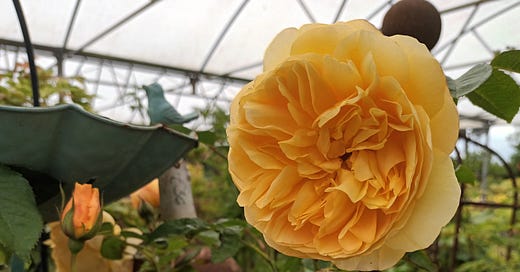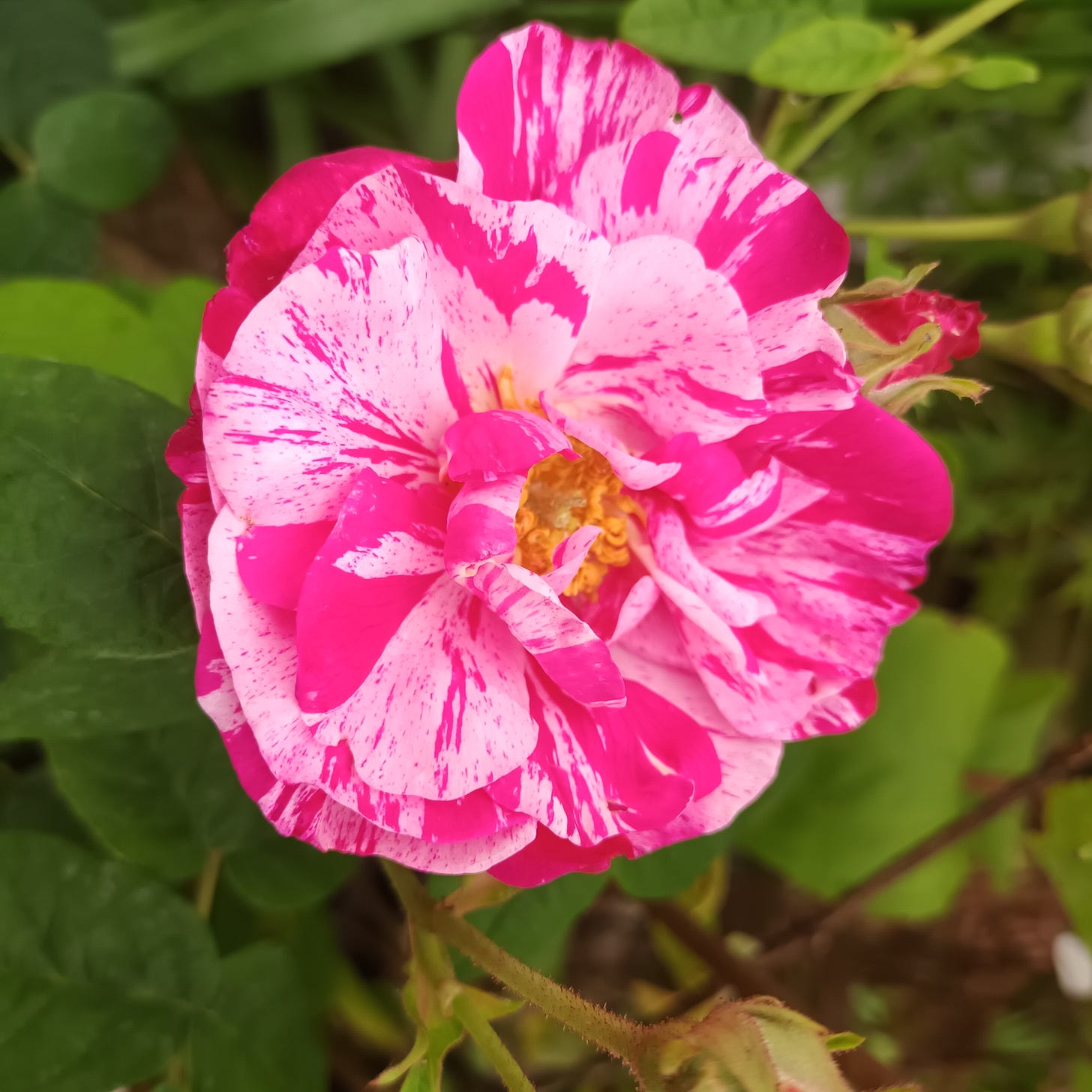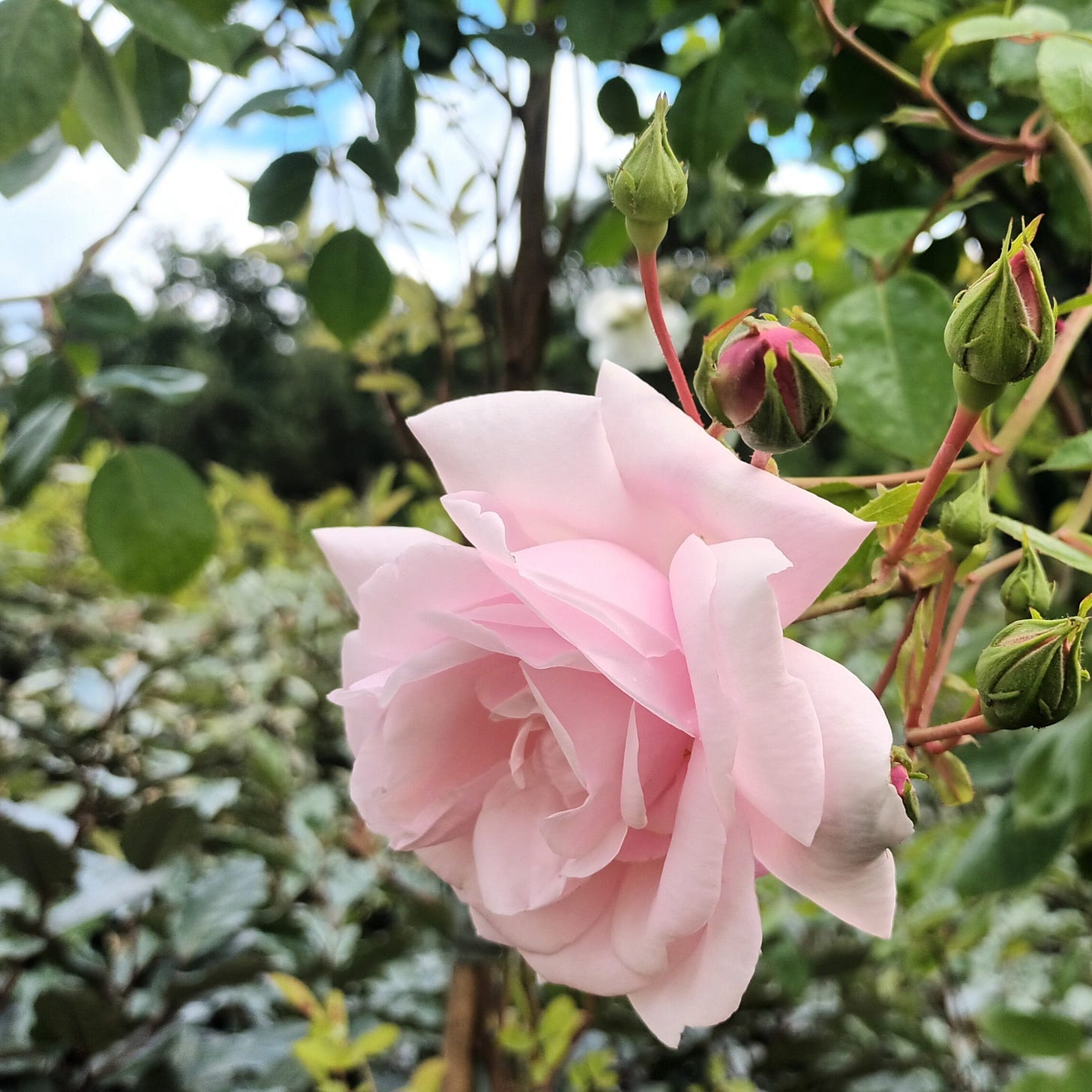A Rose for Derek Jarman
June is the month when everything bursts into celebration, especially the roses. In the nursery, the smoke-blue racemes of wisteria are giving way to the vivid colour of Rosa ‘Paul’s Scarlet’; the scent of star jasmine is overlaid by sweetness of ‘Madame Alfred Carrière,’ whose creamy-white flowers will continue to perfume the air until well into the autumn. Walking out of the shop in the evening, the deep pink petals of roses glow against the blue of agapanthus and white of lilium regale, and the plane tree in the courtyard casts its shadow. It calls to mind Derek Jarman’s description of a trip taken to buy roses for his famous garden at Prospect House:
I arrived at dusk in the nursery set in its little square under the plane trees - it’s a romantic place. Walking around in the deepening gloom through the rows of plants you are drawn into dreams of long summer days, looking at the ageing photos above each plant. Rosa mundi, rose of the world, with its crimson and blush striped flowers, an old sport from the apothecary’s Rosa officinalis, the rose of Provins. It was brought back by a twelfth century crusader and immortalised by Guillaume de Lorris in his poem the Roman de la Rose.’
The image is irresistible. The roses Jarman favoured are the old roses, the gallicas, which were planted in French gardens almost a millennium ago. Smelling them, you can easily understand why medieval apothecaries used them for healing. Rosa officinalis has a wonderful, deep scent, and Rosa mundi bids fair equal to its parent plant. It it is also supremely hardy and disease resistant. For Jarman it thrived on salt-drenched shingle, scoured by storms and scorched in the summer. Like other old roses, it would be an excellent shrub for an exposed site, bringing fragrance and romance into the most inhospitable places.
Alongside the gallicas are dozens and dozens of other roses in every permutation of form and colour. There’s the dramatic ‘Black Baccara,’ an upright hybrid tea with large, velvety flowers that are excellent for cutting. Nothing could be more different a David Austin rose such as ‘The Lady Gardener,’ with its flat, quartered blossoms in subtle shades of peaches and cream, or the arching ‘Canary Bird,’ whose primrose-yellow flowers come into bloom before almost any other rose.
If you want a rambling, romantic, single-flowering rose that will scramble up a tree or blend into wild planting, you might try ‘Rambling Rector,’ with its spice-scented sprays of creamy white flowers. A thornless alternative would be Rosa Banksia ‘lutea,’ whose its tiny butter-yellow flowers resemble scrunched tissue paper; a repeat-flowering option would be the gorgeous pink ‘Zépherine Drouin,’ with its distinctive fruity fragrance. More manageable than these - a climber rather than a rambler - is the beautiful, soft pink ‘New Dawn,’ whose slightly heavy flowers hang in gentle curves that cry out to be trained over an archway or pergola. Both it and the pure white, elegant ‘Iceberg’ are repeat-flowering, with glossy green leaves that would quickly cover a wall or fence. Narrowing down the choices is almost impossible.
Jarman’s depiction of rosa mundi - the crusader’s gift for the poet - is a masterclass in romance. He leaves us with almost no surrounding detail, except the mention of these two men and the rose that passed between them. It would delight, and perhaps surprise him, to know that these days scholars have found many such snippets of similar romances hidden in the poems related to the Roman de la Rose. When Jarman was writing, it must have seemed equally unlikely to imagine that we would ever know whether the romantic story of the crusader and his rose could be the literal truth. All accounts of the parentage and history of roses were based on a tissue of best guesses and historical accounts. Rose genetics are formidably complex - a testimony to their long history of cultivation and hybridisation, and to the fact that many roses are polyploid, with more than two complete sets of chromosomes to play with. Recently, however, rose genomes have been sequenced. We are on the verge of discovering the hidden stories of roses. There could not be a better time to plan a rose garden.

***
All of the roses mentioned in this post are available for sale at Vertigrow. Prices range from £7.50 upwards.
***
Check us out on Instagram: https://www.instagram.com/vertigrowplant/
Vertigrow Plant Nurseries, Lawnswood House, Malton Road, York, YO32 9TL







